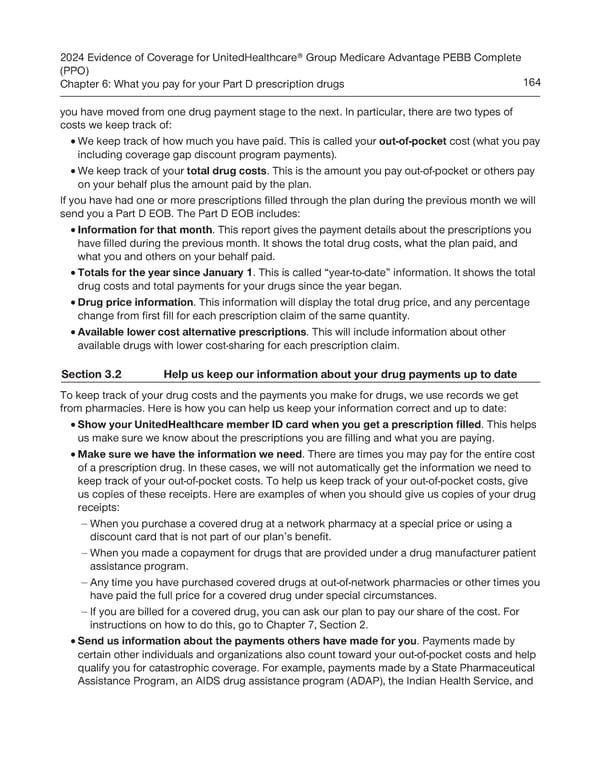2024 Evidence of Coverage for UnitedHealthcare® Group Medicare Advantage PEBB Complete (PPO) Chapter 6: What you pay for your Part D prescription drugs 164 you have moved from one drug payment stage to the next. In particular, there are two types of costs we keep track of: · We keep track of how much you have paid. This is called your out-of-pocket cost (what you pay including coverage gap discount program payments). · We keep track of your total drug costs. This is the amount you pay out-of-pocket or others pay on your behalf plus the amount paid by the plan. If you have had one or more prescriptions filled through the plan during the previous month we will send you a Part D EOB. The Part D EOB includes: · Information for that month. This report gives the payment details about the prescriptions you have filled during the previous month. It shows the total drug costs, what the plan paid, and what you and others on your behalf paid. · Totals for the year since January 1. This is called “year-to-date” information. It shows the total drug costs and total payments for your drugs since the year began. · Drug price information. This information will display the total drug price, and any percentage change from first fill for each prescription claim of the same quantity. · Available lower cost alternative prescriptions. This will include information about other available drugs with lower cost-sharing for each prescription claim. Section 3.2 Help us keep our information about your drug payments up to date To keep track of your drug costs and the payments you make for drugs, we use records we get from pharmacies. Here is how you can help us keep your information correct and up to date: · Show your UnitedHealthcare member ID card when you get a prescription filled. This helps us make sure we know about the prescriptions you are filling and what you are paying. · Make sure we have the information we need. There are times you may pay for the entire cost of a prescription drug. In these cases, we will not automatically get the information we need to keep track of your out-of-pocket costs. To help us keep track of your out-of-pocket costs, give us copies of these receipts. Here are examples of when you should give us copies of your drug receipts: - When you purchase a covered drug at a network pharmacy at a special price or using a discount card that is not part of our plan’s benefit. - When you made a copayment for drugs that are provided under a drug manufacturer patient assistance program. - Any time you have purchased covered drugs at out-of-network pharmacies or other times you have paid the full price for a covered drug under special circumstances. - If you are billed for a covered drug, you can ask our plan to pay our share of the cost. For instructions on how to do this, go to Chapter 7, Section 2. · Send us information about the payments others have made for you. Payments made by certain other individuals and organizations also count toward your out-of-pocket costs and help qualify you for catastrophic coverage. For example, payments made by a State Pharmaceutical Assistance Program, an AIDS drug assistance program (ADAP), the Indian Health Service, and
 UnitedHealthcare PEBB Complete EOC (2024) Page 169 Page 171
UnitedHealthcare PEBB Complete EOC (2024) Page 169 Page 171